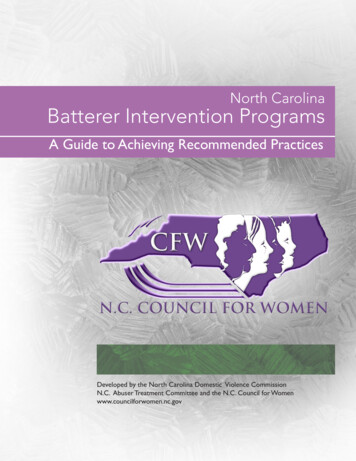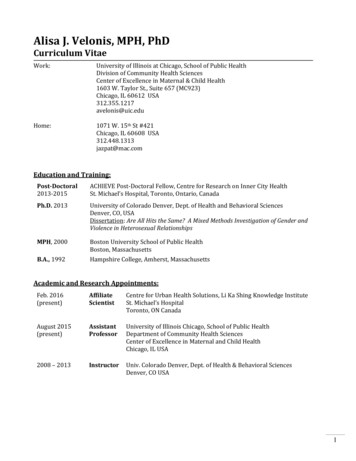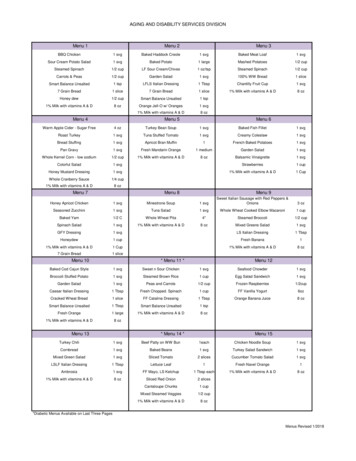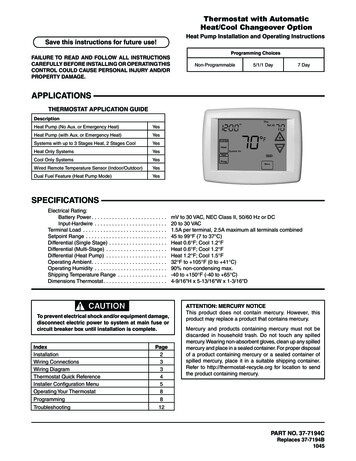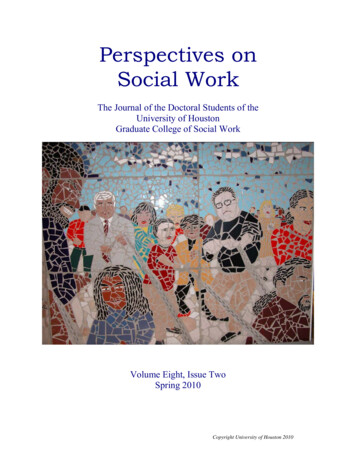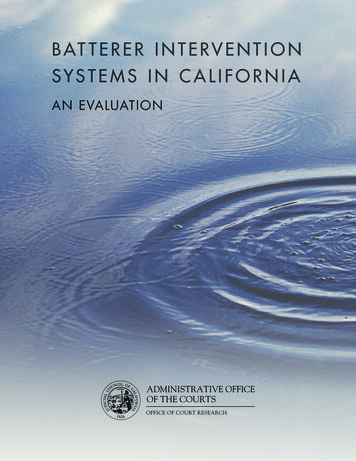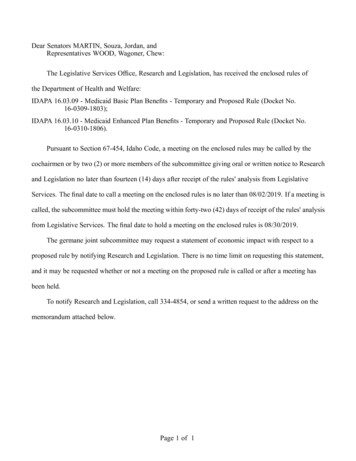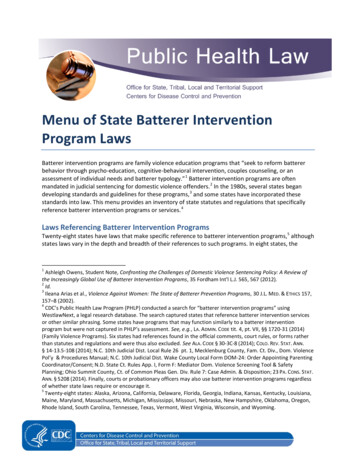
Transcription
Menu of State Batterer InterventionProgram LawsBatterer intervention programs are family violence education programs that “seek to reform battererbehavior through psycho-education, cognitive-behavioral intervention, couples counseling, or anassessment of individual needs and batterer typology.” 1 Batterer intervention programs are oftenmandated in judicial sentencing for domestic violence offenders. 2 In the 1980s, several states begandeveloping standards and guidelines for these programs, 3 and some states have incorporated thesestandards into law. This menu provides an inventory of state statutes and regulations that specificallyreference batterer intervention programs or services. 4Laws Referencing Batterer Intervention ProgramsTwenty-eight states have laws that make specific reference to batterer intervention programs, 5 althoughstates laws vary in the depth and breadth of their references to such programs. In eight states, the1Ashleigh Owens, Student Note, Confronting the Challenges of Domestic Violence Sentencing Policy: A Review ofthe Increasingly Global Use of Batterer Intervention Programs, 35 Fordham Int'l L.J. 565, 567 (2012).2Id.3Ileana Arias et al., Violence Against Women: The State of Batterer Prevention Programs, 30 J.L. MED. & ETHICS 157,157–8 (2002).4CDC’s Public Health Law Program (PHLP) conducted a search for “batterer intervention programs” usingWestlawNext, a legal research database. The search captured states that reference batterer intervention servicesor other similar phrasing. Some states have programs that may function similarly to a batterer interventionprogram but were not captured in PHLP’s assessment. See, e.g., LA. ADMIN. CODE tit. 4, pt. VII, §§ 1720-31 (2014)(Family Violence Programs). Six states had references found in the official comments, court rules, or forms ratherthan statutes and regulations and were thus also excluded. See ALA. CODE § 30-3C-8 (2014); COLO. REV. STAT. ANN.§ 14-13.5-108 (2014); N.C. 10th Judicial Dist. Local Rule 26 pt. 1, Mecklenburg County, Fam. Ct. Div., Dom. ViolencePol’y & Procedures Manual; N.C. 10th Judicial Dist. Wake County Local Form DOM-24: Order Appointing ParentingCoordinator/Consent; N.D. State Ct. Rules App. I, Form F: Mediator Dom. Violence Screening Tool & SafetyPlanning; Ohio Summit County, Ct. of Common Pleas Gen. Div. Rule 7: Case Admin. & Disposition; 23 PA. CONS. STAT.ANN. § 5208 (2014). Finally, courts or probationary officers may also use batterer intervention programs regardlessof whether state laws require or encourage it.5Twenty-eight states: Alaska, Arizona, California, Delaware, Florida, Georgia, Indiana, Kansas, Kentucky, Louisiana,Maine, Maryland, Massachusetts, Michigan, Mississippi, Missouri, Nebraska, New Hampshire, Oklahoma, Oregon,Rhode Island, South Carolina, Tennessee, Texas, Vermont, West Virginia, Wisconsin, and Wyoming.
reference is brief and does not provide any substantive information about the program. 6 For example, inSouth Carolina, the only law referencing a batterer intervention program is in a section on communitydomestic violence coordinating councils stating that membership on the council “may include, but is notlimited to representatives from . . . batterer intervention programs . . .” 7 In Louisiana, the only referenceis within a code section regulating Family Violence Program Minimum Standards. 8 The law states thatbatterer intervention services “are not allowed to take place on or near the premises of the familyviolence program.” 9Use of Batterer Intervention ProgramsIn the remaining 20 states, the references to batterer intervention programs are more substantial. 10 Inthese states, judicial officers 11 consider batterer interventions in both criminal and family lawproceedings. 12 Relevant provisions in each state specify whether the judicial officer’s consideration isexclusively mandatory, 13 exclusively discretionary, 14 or both. 15ALASKA STAT. ANN. § 25.24.150 (2014); ARIZ.R. PROT. ORD. PROC. 1 (2014); CAL. PENAL CODE § 1203.097 (2014); DEL. CODEANN. tit. 11, § 3906 (2014); FLA. STAT. ANN. § 741.31 (2014); GA. CODE ANN. § 19-13-10 (2014); IND. CODE ANN. § 31-1414-5 (2014); KAN. STAT. ANN. § 21-5414 (2014); 920 KY. ADMIN. REGS. 2:020 (2014); LA. ADMIN. CODE tit. 4, pt. VII, § 1730(2014); ME. REV. STAT. ANN. tit. 19-A, § 1653 (2014); MD. CODE ANN., FAM. LAW § 4-703 (2014); MASS. GEN. LAWS ANN. CH.209A, § 3 (2014); MICH. COMP. LAWS ANN. § 552.605E (2014); MISS. CODE ANN. § 93-21-101 (2014); MO. ANN. STAT. §455.549 (2014); NEB. REV. STAT. ANN. § 43-2928 (2014); N.H. REV. STAT. ANN. § 173-B:5 (2014); OKLA. STAT. ANN. tit. 74, §18P-1 (2014); OR. ADMIN. R. 137-087-0000 (2014); 9-1 R.I. CODE R. § 1 (2014); S.C. CODE ANN. § 43-1-260 (2013); TENN.COMP. R. & REGS. 0490-01-.01 (2014); TEX. CODE CRIM. PROC. ANN. ART. 42.141 (2013); VT. STAT. ANN. tit. 15, § 1140(2014); W. VA. CODE ANN. § 48-26-203 (2014); WIS. STAT. ANN. § 969.02 (2013); WY ADC ATTG VS CH. 8 S 11.6Eight states: Georgia, Kentucky, Louisiana, Maryland, Mississippi, South Carolina, Vermont, Wyoming. GA CODEANN. § 19-13-10 (2014); KY. ADMIN. REGS. 2:020 (2014); LA. ADMIN. CODE tit. 4, pt. VII, § 1730 (2014); MD. CODE ANN.,FAM. LAW § 4-703 (2014); MISS. CODE ANN. § 93-21-101 (2014); S.C. CODE ANN. § 43-1-260 (2013); VT. STAT. ANN. tit. 15,§ 1140 (2014); WY ADC ATTG CH. 8 §11 (Unlike other states, in Wyoming, under the Attorney General’s VictimServices chapter, law specifically states that BIPs are not considered to be the main resource for domestic violencevictims: “BIPs are not the primary resource to victims of domestic violence and sexual assault programs” and that“(p)rograms should refrain from attempting to provide these services where possible.)7S.C. CODE ANN. § 43-1-260 (2013).8LA. ADMIN. CODE tit. 4, PT. VII, § 1730 (2014).9Id.10Twenty states: Alaska, Arizona, California, Delaware, Florida, Indiana, Kansas, Maine, Massachusetts, Michigan,Missouri, Nebraska, New Hampshire, Oklahoma, Oregon, Rhode Island, Tennessee, Texas, West Virginia,Wisconsin. ALASKA STAT. ANN. § 25.24.150 (2014); ARIZ.R. PROT. ORD. PROC. 1 (2014); CAL. PENAL CODE § 1203.097(2014); DEL. CODE ANN. tit. 11, § 3906 (2014); FLA. STAT. ANN. § 741.31 (2014); IND. CODE ANN. § 31-14-14-5 (2014);KAN. STAT. ANN. § 21-5414 (2014); ME. REV. STAT. ANN. tit. 19-A, § 1653 (2014); MASS. GEN. LAWS ANN. ch. 209A, § 3(2014); MICH. COMP. LAWS ANN. § 552.605e (2014); MO. ANN. STAT. § 455.549 (2014); NEB. REV. STAT. ANN. § 43-2928(2014); N.H. REV. STAT. ANN. § 173-B:5 (2014); OKLA. STAT. ANN. tit. 74, § 18p-1 (2014); OR. ADMIN. R. 137-087-0000(2014); 9-1 R.I. CODE R. § 1 (2014); TENN. COMP. R. & REGS. 0490-01-.01 (2014); TEX. CODE CRIM. PROC. ANN. art. 42.141(2013); W. VA. CODE ANN. § 48-26-203 (2014); WIS. STAT. ANN. § 969.02 (2013).11This term includes courts, judges, and parole and probationary officers.12If a state had a body of law that included both mandatory laws, discretionary laws or both as well as unclearlaws, it was categorized based on the laws that had affirmative mandatory or discretionary language. Unclear inthis context means those laws that suggest that judicial officers can consider a BIP but do not include any languageto indicate whether or not it is mandatory or discretionary.13Mandatory laws include laws that mandate an assessment by a BIP program and subsequent compliance withthose recommendations. See DEL. CODE ANN. tit. 11, § 3906 (2014); KAN. STAT. ANN. § 21-6604 (2014).14Discretionary laws include laws that allow assessment by a BIP program and subsequent compliance with thoserecommendations. See KAN. STAT. ANN. § 21-5414 (2014).2
Criminal Law 16In eight states, judicial officers consider batterer intervention programs only in the criminal lawcontext. 17 Among these eight states, there is variation in whether it is exclusively mandatory, 18exclusively discretionary, 19 or both mandatory and discretionary, for a judicial officer to consider anintervention. 20 In addition, in one state, the relevant provision at issue does not provide enough clarityor specificity in order to make a determination about whether the provision is mandatory ordiscretionary. 21In two states, the judicial officer is mandated by law to consider a batterer intervention program. 22 Forexample, in California, if “a person is granted probation for a crime in which the victim is a persondefined in Section 6211 of the Family Code, the terms of probation shall include all of the following . . .(s)uccessful completion of a batterer's program.” 23In four states, the judicial officer has the discretion to decide whether or not to consider a battererintervention program. 24 For example, in Wisconsin, in a case where a defendant charged with amisdemeanor is released, “(i)f the person is charged with violating a restraining order or injunctionissued under s. 813.12 or 813.125” the judge “may require the person to participate in . . . a batterer'sintervention program.” 25 In Oregon, the Board of Parole may consider batterer intervention enrollmentwhen setting parole deferral periods. 2615“Both” refers to the circumstance where the state has a body of law under which ordering or considering BIPenrollment is mandatory in some circumstances and discretionary in others.16Probationary hearings are included in the criminal law category. This category also includes two states underwhose body of law the court, probation and parole, as well as state family social services agencies such as thedepartment of children and families, can make referrals to BIPs. There was no additional reference linking thesocial services agency to a judicial officer; therefore, the provisions were categorized as criminal and not both. SeeOR. ADMIN. R. 137-087-0030(2014); W. VA. CODE ANN 48-26-701 (2014).17Eight states: California, Delaware, Kansas, New Hampshire, Oregon, Tennessee, West Virginia, Wisconsin. CAL.PENAL CODE § 1203.097 (2014); DEL. CODE ANN. TIT. 11, § 3906 (2014); KAN. STAT. ANN. § 21-5414 (2014); NH R DOMVIOLENCE PROTOCOL 13-3. (This provision clearly sets standards for BIP use in the criminal context. There are otherprovisions in New Hampshire, see NH R DOM VIOLENCE PROTOCOLS 7H, 7-27, 19-1, 19-5, 19-6, that could potentially beapplicable to the family law context as well; however, not enough information is given to make that determinationand, therefore, the placement of New Hampshire’s body of law is in criminal law.); OR. ADMIN. R. 137-087-0030(2014); TENN. CODE ANN. § 40-35-303 (2014); W. VA. CODE ANN 48-26-701 (2014); WIS. STAT. ANN. § 969.02 (2013).18Two states: California and Delaware. CAL. PENAL CODE § 1203.097 (2014); DEL. CODE ANN. tit. 11, § 3906 (2014).19Four states: New Hampshire, Oregon, Tennessee, Wisconsin. NH R DOM VIOLENCE PROTOCOL 19-1; OR. ADMIN. R.255-062-0016 (2014); TENN. CODE ANN. § 40-35-303 (2014) (A judge may set a probationary period if it is needed inorder to complete a BIP.); WIS. STAT. ANN. § 969.02 (2013).20One state: Kansas. KAN. STAT. ANN. § 21-5414 (2014).21One state: West Virginia. W. VA. CODE ANN 48-26-701 (2014).22Two states: California and Delaware. CAL. PENAL CODE § 1203.097 (2014); DEL. CODE ANN. tit. 11, § 3906 (2014).23CAL. PENAL CODE § 1203.097 (2014).24Four states: New Hampshire, Oregon, Tennessee, Wisconsin. NH R DOM VIOLENCE PROTOCOL 19-1; OR. ADMIN. R.255-062-0016 (2014); TENN. CODE ANN. § 40-35-303 (2014); WIS. STAT. ANN. § 969.02 (2013).25WIS. STAT. ANN. § 969.02 (2013).26OR. ADMIN. R. 255-062-0016 (2014).3
In one state, Kansas, ordering a batterer intervention program is mandatory in some circumstances anddiscretionary in others. 27 For a class B misdemeanor crime of domestic battery, “the court may,” at itsdiscretion, “enter an order that requires the offender to undergo a domestic violence offenderassessment conducted by a certified batterer intervention program and follow all recommendationsmade by such program.” 28 When a domestic battery crime rises to the level of a class A misdemeanor ora person felony, “(a)s a condition of any grant of probation, suspension of sentence or parole or of anyother release, the offender shall be required to undergo a domestic violence offender assessmentconducted by a certified batterer intervention program and follow all recommendations made by suchprogram.” 29In one state, West Virginia, the relevant provision does not provide the specificity required to determinewhether or not ordering a batterer intervention program is mandatory or discretionary.30 The law statesthat an intervention program may report to the court “if the participation was court ordered” but doesnot provide additional information about whether the court order was mandated by law or ordered atthe judge’s discretion. 31Family Law 32In three states, judicial officers consider batterer intervention programs only in the family law context. 33State laws vary with regard to the judicial officer’s role; in the family law context, the judicial officer’sconsideration is either exclusively discretionary 34 or both mandatory and discretionary. 35In two states, the decision to order a batterer intervention program in family law is exclusivelydiscretionary. 36 For example, in Michigan, when considering support and parenting time enforcement,the “court shall require conditions . . . in addition to the payment of support that the court determinesare in the best interests of a child, including, but not limited to . . . participation in a battererintervention program that meets the standards recommended by the governor's task force on battererintervention standards.”37In one state, Alaska, the decision to consider a batterer intervention program is both mandatory anddiscretionary. 38 With regard to visitation, the court will allow only supervised visitation by a parent witha history of domestic violence “conditioned on that parent's participating in and successfully completingan intervention program for batterers.” 39 With regard to custody, the provision establishes a rebuttablepresumption that a parent with a history of domestic violence will not be given custody of his or her27One state: Kansas. KAN. STAT. ANN. § 21-5414 (2014).KAN. STAT. ANN. § 21-5414 (2014).29Id.30One state: West Virginia. W. VA. CODE ANN. 48-26-701 (2014).31Id.32For the purposes of the menu, Family Law includes both family law and domestic relations law that address suchissues as custody and parenting time.33Three states: Alaska, Michigan, Nebraska. ALASKA STAT. ANN. § 25.24.150 (2014); MICH. COMP. LAWS ANN. § 552.605E(2014); NEB. REV. STAT. § 43-2928 (2014).34Two states: Michigan, Nebraska. MICH. COMP. LAWS ANN. § 552.605E (2014); NEB. REV. STAT. § 43-2928 (2014).35One state: Alaska. ALASKA STAT. ANN. § 25.24.150 (2014).36Two states: Michigan and Nebraska. MICH. COMP. LAWS ANN. § 552.605E (2014); NEB. REV. STAT. § 43-2928 (2014).37MICH. COMP. LAWS ANN. § 552.605E (2014).38One state: Alaska. ALASKA STAT. ANN. § 25.24.150 (2014).39Id.284
child. 40 However, at the court’s discretion, “(t)he presumption may be overcome by a preponderance ofthe evidence that the perpetrating parent has successfully completed an intervention program forbatterers,” among other factors. 41Both Criminal and Family Law 42In seven states, judicial officers may consider batterer interventions in both the criminal and family lawcontexts. 43 Relevant state laws vary as to whether a judicial officer’s consideration is exclusivelydiscretionary 44 or both mandatory and discretionary, depending on the circumstances. 45In four states, the decision to order a batterer intervention program is strictly discretionary. 46 In Indiana,in the family law context, “(a)s a condition of granting the noncustodial parent unsupervised parentingtime, the court may require the noncustodial parent to complete a batterer’s intervention programcertified by the Indiana coalition against domestic violence.” 47 In the criminal law context, “(a)t the timeof sentencing for a person convicted of domestic battery . . . or a crime that involved domestic abuse,neglect, or violence, the court may require the person to complete a batterer's intervention programapproved by the court.” 48In three states, the decision is both mandatory in certain circumstances and discretionary in others. 49 InMassachusetts, for example, if a batterer violates an abuse prevention order, the court must “order the40Id.Id.42A state’s body of law was is included in this section when they have a law or a grouping of laws that address theuse of BIPs in both the criminal and family law contexts.43Seven states: Arizona, Florida, Indiana, Maine, Massachusetts, Rhode Island, Texas. ARIZ. R. FAM. P. 95 (2014); FLA.STAT. ANN. § 741.31 (2014); FLA. STAT. ANN. § 741.30 (2014); IND. CODE ANN. § 31-14-14-5 (2014); IND. CODE ANN. § 3550-9-1; ME. REV. STAT. tit. 19-A, § 1653 (2014); ME. REV. STAT. ANN. tit. 17-A, § 1204 (2014); MASS. GEN. LAWS ANN. CH.209A, § 7 (2014); MASS. GEN. LAWS ANN. CH. 209A § 3; R.I. GEN. LAWS 1956, § 15-5-16 (2014); 9-1 R.I. CODE R. § 1 (2014);TEX. FAM. CODE ANN. § 153.004 (2013).44Four states: Arizona, Indiana, Maine, Texas. ARIZ. R. FAM. P. 95 (2014); ME. REV. STAT. tit. 19-A, § 1653 (2014); ME.REV. STAT. ANN. tit. 17-A, § 1204 (2014); IND. CODE ANN. § 31-14-14-5 (2014); IND. CODE ANN. § 35-50-9-1 (2014); TEX.FAM. CODE ANN. § 153.004 (2013); TEX. CODE CRIM. PROC. ANN. ART. 42.141 (2013). (Texas has a family law that isdiscretionary see TEX. FAM. CODE ANN. § 153.004 (2013) and a law that is applicable to both criminal and family lawthat is unclear as to whether the provision is mandatory or discretionary see TEX. CODE CRIM. PROC. ANN. ART. 42.141(2013).)45Three states: Florida, Massachusetts, Rhode Island. FLA. STAT. ANN. § 741.31 (2014); FLA. STAT. ANN. § 741.30(2014); MASS. GEN. LAWS ANN. CH. 209A, § 7 (2014); MASS. GEN. LAWS ANN. CH. 209A § 3 (Massachusetts has family lawsthat are discretionary and criminal laws that are either mandatory or both.); R.I. GEN. LAWS 1956, § 15-5-16 (2014);R.I. GEN. LAWS ANN. § 12-29-5 (2014) (Rhode Island has a family law that is discretionary and criminal laws that aremandatory or unclear.)46Four states: Arizona, Indiana, Maine, Texas. ARIZ. R. FAM. P. 95 (2014); IND. CODE ANN. § 31-14-14-5 (2014); IND.CODE ANN. § 35-50-9-1; ME. REV. STAT. tit. 19-A, § 1653 (2014); ME. REV. STAT. ANN. tit. 17-A, § 1204 (2014); TEX. FAM.CODE ANN. § 153.004 (2013).47IND. CODE ANN. § 31-14-14-5 (2014).48Id.49Three states: Florida, Massachusetts, Rhode Island. FLA. STAT. ANN. §§ 741.30-741.31 (2014); MASS. GEN. LAWS ANN.CH. 209A, § 7 (2014); MASS. GEN. LAWS ANN. CH. 209A, § 3 (Massachusetts has family laws that are discretionary andcriminal laws that are either mandatory or both.) R.I. GEN. LAWS 1956, § 15-5-16 (2014); R.I. GEN. LAWS ANN. § 12-29-5(2014) (Rhode Island has a family law that is discretionary and criminal laws that are mandatory and unclear.)415
defendant to complete a certified batterer's intervention program .” 50 However, when grantingvisitation to an abusive parent, “(t)he court may consider . . . ordering the abusive parent to attend andcomplete, to the satisfaction of the court, a certified batterer’s treatment program as a condition ofvisitation.” 51General Judicial AuthorityIn one state, the source of law is neither criminal nor family. 52 In Oklahoma, standards and criteria forbatterer intervention programs are established under the attorney general’s title. In that section, thelanguage specifies that batterers can be “court-ordered” to attend intervention programs 53 but does notindicate whether the court is mandated to order the batterer intervention program or has the discretionto do so.In one state, Missouri, the relevant provision indicates that the court can order a batterer interventionprogram but does not specify the type of proceeding in which a program could be ordered. The lawstates only that there shall be “rules to establish standards and to adopt a credentialing process for anycourt-appointed batterer intervention program.” 54 However, neither the language in the law nor theplacement in the statute indicates whether an intervention program can be court-ordered in criminal,family, or both settings. In addition, the provision does not specify whether the court appointed BIPs aremandatory or discretionary.Program LengthOnly eight states have laws addressing the length of a batterer intervention program. 55 Three states’laws set program length in hours, weeks, or months. 56 Two states set program length in number ofsessions. 57 Finally, three states set program length in terms of both time and number of sessions. 58State provisions vary with regard to the minimum duration of a program. For example, in Maine, thelength of the program “will be a minimum of 48 weeks in duration,” and “(e)ach weekly session will beat least 90 minutes long, with check-in consuming no more than 30 minutes.” 59 Tennessee requires aminimum of 24 class sessions “to meet discharge criteria”. 60 In California, if a person convicted of adomestic violence crime is granted probation, the terms of their probation must include a battererintervention program “for a period not less than one year,” including “weekly sessions of a minimum of50MASS. GEN. LAWS ANN. CH. 209A, § 7 (2014).Id. § 3 (2014).52One state: Oklahoma. OKLA. ADMIN. CODE 75:25-3-4(2014).53Id.54One state: Missouri. MO. ANN. STAT. § 455.549 (2014).55Eight states: California, Florida, Maine, New Hampshire, Oklahoma, Oregon, Rhode Island, Tennessee. CAL. PENALCODE § 1203.097 (2014); FLA. STAT. ANN. § 741.325 (2014); 03-201; ME. CODE R. CH. 15 § 4 (2014); NH R. DOM. VIOLENCECH. 19.B; OKLA. ADMIN. CODE § 75:25-3-1 (2014); OR. ADMIN. R. 137-087-0065 (2014); 9-1 R.I. CODE R. § 1 (2014); TENN.COMP. R. & REGS. 0490-01-.01 (2014).56Three states: Maine, New Hampshire, Rhode Island. ME. CODE R. CH. 15 § 4 (2014); NH R. DOM. VIOLENCE CH. 19.B;9-1 R.I. CODE R. § 1 (2014).57Two states: Oregon and Tennessee. OR. ADMIN. R. 137-087-0065 (2014); TENN. COMP. R. & REGS. 0490-01-.01(2014).58Three states: California, Florida, Oklahoma. CAL. PENAL CODE § 1203.097 (2014); FLA. STAT. ANN. § 741.325 (2014);OKLA. ADMIN. CODE § 75:25-3-1 (2014).59ME. CODE R. CH. 15 § 4 (2014).60TENN. COMP. R. & REGS. 0490-01-.05 (2014).516
two hours class time duration,” and the program must be completed in 18 months. 61 In Florida,programs must be “at least 29 weeks in length and include 24 weekly sessions.” 62Entities That Certify, License, and Establish StandardsSixteen states designate specific entities to certify, license, or establish standards for battererintervention programs, 63 such as attorneys general, departments of health, departments of corrections,and others. In five of these states, multiple entities are involved. 64Department of HealthIn two states, Arizona and Massachusetts, the department of health sets standards for battererintervention programs. 65 In Arizona, a court can order attendance at a program “approved by theArizona Department of Health Services,” and in Massachusetts, a judge can recommend a program“certified by the department of public health.” 66Departments of Correction, Criminal Justice, or ProbationIn five states, California, Maine, Missouri, Rhode Island, and Texas, either the department ofcorrections, department of probation, or department of criminal justice is involved in the standard61CAL. PENAL CODE § 1203.097 (2014).FLA. STAT. ANN. § 741.325 (2014).63Sixteen states: Arizona, California, Delaware, Florida, Indiana, Kansas, Maine, Massachusetts, Michigan,Missouri, Oklahoma, Oregon, Rhode Island, Tennessee, Texas, West Virginia. ARIZ. R. FAM. P. 95 (2014) (Departmentof Health Services); CAL. PENAL CODE § 1203.097 (2014) (Probation Department along with agencies and domesticviolence victim advocacy programs); 11 DEL. ADMIN. CODE § 3906 (2014) (Domestic Violence Coordinating Council);FLA. STAT. ANN. § 741.325 (2014) (Set by Law); IND. CODE ANN. § 35-50-9-1 (2014) (Indiana Coalition); KAN. STAT. ANN.§ 75-7d01 (2014) (Attorney General Batterer Intervention Program Certification Unit); ME. REV. STAT. ANN. tit. 19,§ 4014 (2014) (Department of Corrections in consultation with the Maine Commission on Domestic and SexualAbuse); MASS. GEN. LAWS ANN. ch. 209a, § 3 (2014) (Department of Public Health); MICH. COMP. LAWS ANN. § 552.605e(2014) (Governor’s Task Force on Batterer Intervention Standards); MO. ANN. STAT. § 455.549 (2014) (Division ofProbation and Parole within the Department of Corrections); OKLA. ADMIN. CODE § 75:25-1-3 (2014) (AttorneyGeneral); OR. ADMIN. R. 137-087-0000 (2014), OR. REV. STAT. § 180.710 (2014) (Attorney General to adopt rules andLSA with Domestic Violence Coordinating Council to enforce); 9-1 R.I. Code R. § 1 (2014) (Batterers InterventionProgram Standards Oversight Committee), 9-1 R.I. Code R. § 1:2 (Rhode Island Department of Corrections/AdultProbation and Parole); TENN. CODE ANN. § 38-12-110 (2014) (State Coordinating Council); TEX. CODE CRIM. PROC. ANN.art. 42.141 (2014) (The Community Justice Assistance Division of the Texas Department of Criminal Justice with theassistance of the statewide nonprofit organization described by Section 3(1)); W. VA. CODE R. § 48-26-401 (2014)(Family Protection Services Board).64Five states: California, Maine, Oregon, Rhode Island, Texas. CAL. PENAL CODE § 1203.097 (2014) (ProbationDepartment along with agencies and domestic violence advocacy programs); ME. REV. STAT. ANN. tit. 19, § 4014(2014) (Department of Corrections in consultation with the Maine Commission on Domestic and Sexual Abuse); OR.ADMIN. R. 137-087-0000 (2014), OR. REV. STAT. § 180.710 (2014) (Attorney General to adopt rules and LSA withDomestic Violence Coordinating Council to enforce); 9-1 R.I. CODE R. § 1 (2014) (Batterers Intervention ProgramStandards Oversight Committee), 9-1 R.I. CODE R. § 1:2 (Rhode Island Department of Corrections/Adult Probationand Parole); TEX. CODE CRIM. PROC. ANN. art. 42.141 (2014) (The Community Justice Assistance Division of the TexasDepartment of Criminal Justice with the assistance of the statewide nonprofit organization described by Section3(1)).65Two States: Arizona and Massachusetts. ARIZ. R. FAM. P. 95 (2014); MASS. GEN. LAWS ANN. CH. 209A, § 3 (2014).66Id.627
setting process for that state. 67 For example, in Maine, the relevant provision indicates that thedepartment of corrections is solely responsible for “establish(ing) standards and procedures forcertification of batterers’ intervention programs” as well as “review(ing) and certify(ing) programs thatmeet the standards.” 68 In Missouri, the “division of probation and parole within the department ofcorrections shall promulgate rules to establish standards and to adopt a credentialing process for anycourt-appointed batterer intervention program.” 69Office of the Attorney GeneralIn three states, Kansas, Oklahoma, and Oregon, rules are established by the office of the attorneygeneral. 70 For example, in Kansas, a statute creates “in the office of the attorney general a battererintervention program certification unit.” 71 Oregon gives the “Attorney General authority, in consultationwith an advisory committee, to adopt rules that establish standards for batterers' interventionprograms.” 72Domestic Violence Coordinating CouncilsIn three states, Delaware, Oregon, and Tennessee, domestic violence coordinating councils aredelegated the task of setting standards for batterer intervention programs. 73 For instance, in Tennessee,“(t)he state coordinating council shall promulgate regulations for batterers’ intervention programs . . .and shall certify compliance with the regulations.” 74 In Oregon, the Domestic Violence CoordinatingCouncil along with a Local Supervisory Authority is responsible for standard enforcement. 75Family Services Protection BoardIn West Virginia, the Family Services Protection Board “(r)eceive(s) and consider(s) applications forlicensure of . . . batterer intervention and prevention programs” and “(a)ssess(es) the need for . . .batterer intervention and prevention programs . . . including licensure preapplication and applicationprocesses.” 76Governor’s Task ForceIn Michigan, the governor’s task force serves as the standard setting body. 77 The court can consider“participation in a batterer intervention program that meets the standards recommended by thegovernor's task force on batterer intervention standards.” 7867Five states: California, Maine, Missouri, Rhode Island, Texas. CAL. PENAL CODE § 1203.097 (2014); ME. REV. STAT.ANN. tit. 19, § 4014 (2014); MO. ANN. STAT. § 455.549 (2014); 9-1 R.I. Code R. § 1, 1:2; TEX. CODE CRIM. PROC. ANN. art.42.141 (2014).68ME. REV. STAT. ANN. tit. 19, § 4014 (2014).69MO. ANN. STAT. § 455.549 (2014).70Three States: Kansas, Oklahoma, Oregon. KAN. STAT. ANN. § 75-7D01 (2014); OKLA. ADMIN. CODE § 75:25-1-3; OR.ADMIN. R. 137-087-0000 (2014).71KAN. STAT. ANN. § 75-7D01 (2014).72OR. ADMIN. R. 137-087-0000 (2014).73Three states: Delaware, Oregon, Tennessee. 11 DEL. ADMIN. CODE § 3906 (2014); ); OR. REV. STAT. § 180.710 (2014);TENN. CODE ANN. § 38-12-110 (2014).74TENN. CODE ANN. § 38-12-110 (2014).75OR. REV. STAT. § 180.710 (2014).76One state: West Virginia. W. VA. CODE, § 48-26-401(2014).77One State: Michigan. MICH. COMP. LAWS ANN. § 552.605E (2014).78Id.8
Court SystemFlorida has no certification body specified in the relevant provisions. 79 However, standards are set bythe court, and it is the responsibility of “the court and others who make referrals [to] refer perpetratorsonly to programming that appropriately addresses the violence committed.” 80Advisory CommitteeIn Oregon, the Attorney General has “authority, in consultation with an advisory committee, to adoptrules that establish standards for batterers’ intervention programs.” 81 Further, a “local supervisoryauthority, in consultation with a local domestic violence coordinating council . . . may periodically reviewbatterers’ intervention programs.” 82Batterers Intervention Program
. § 48-26-203 (2014); W. IS. S. TAT. A. NN. § 969.02 (2013). 11 . This term includes courts, judges, and parole and probationary officers. 12 . If a state had a body of law that included both mandatory laws, discretionary laws or both as well as unclear laws, it was categorized based on the laws that had affirmative mandatory or discretionary .
